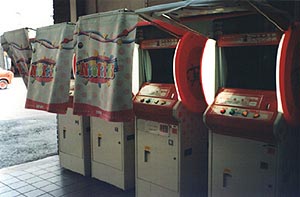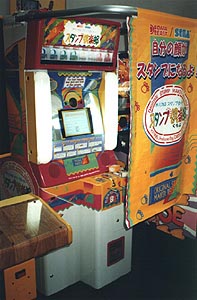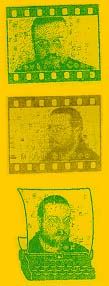
Sell Me Myself
David Cox finds the self in a photo-me booth.
New Devices for recording one's own image have cropped up in the city. We
are all familiar with the photo-me booths - those rather boxy tiny rooms
with a curtain into which you place coins and a strip of photos is
produced.
Photo-me booths date back to the late 1950s and early 1960s and were
popularised by such films as La Dolce Vita in which the main character
records various stages of her anguish in a series of photos which cartoon
strip like show the tears about to come, then her crying and the final shot
showing her with head in hands. An amazing sequence, summing up the effect
of paparazzi upon the very famous and the very public. Perhaps even poignant
in the wake of the untimely death of Princess Diana, whose own La Dolce
Vita, was mediated so entirely by lens.
Another film featuring the photo me booth which comes to mind is the opening
sequence of the Beatles film Hard Days Night directed by Richard Lester. A
member of the fab four enters a booth at a railway station (I think it is
Paul) and has his photo taken to evade the pursuit of hundreds of teeny
boppers.
They were everywhere at one stage - particularly near where passports are
processed, such as the post office (there is one near the General Post
Office in Melbourne) and at railway stations - the little black and white or
colour shots perfect for adorning the documents of officialdom with a little
glue, tape or a paper clip. I needed one recently for my US visa, as the US
government now digitises the photos and uses them as part of the visa itself
- a low res dot matrixed image interwoven with complex lines like currency.
Photo-me booths were usually used mainly for recreation - for those familiar
images of young couples kissing, or kids pulling faces. But the construction
and instructions and the mirror stuck on the outside usually connoted more
officialdom than fun. The flashes going off, the curtain, the clunky sounds
they made as they processed the film - all the internal pulleys and
mechanisms dragging a piece of photosensitive paper through its innards.
Someone had to come and replace the developer and fixer and water at regular
intervals and photo-me booths were definitely the culmination of vending
machines, amusement arcadia, and like cigarette machines, coke machines and
public phones were place where people passed through, in transit. Places
where a photo would offer a reminder to someone left behind, or otherwise
assist with the complex demands society places on the importance of a
portrait for the needs of identification and memory.

Digital technology has spawned a new variation on the phone-me booth, this
time with recreation as its primary function. These are made by Sega, the
videogames giant and are to be found in the amusement arcades. Called
Neoprint, the machines, often lined up in rows of three or four, create not
photos in the sense of simple strips of wet paper with little portraits, but
rather many tiny little photographs each about 1.5 cm across by 1cm high
which are printed onto adhesive backed plastic sheets stamped into an array
of four by four stickers.
Neoprint machines use a built in video camera and digitiser to capture the
users face, and by navigating a fairly simple computer screen interface, one
can capture ones own portrait, retry if the first takes don't work, then
choose different presentation formats for the total of 16 to a page
stickers. Options include having little captions underneath them, which say
such things as Thank You or For You or Congratulations or I Love You.
Other options include black and white and wide screen to make the image look
like a 35mm motion picture still (I particularly like this one!).
Appealing directly to the narcissism of adolescents (like me), the devices
are placed prominently near the doors to amusement arcades, and are decked
out in bright pinks and iridescent sweet colours like lime green. They are
beautifully designed as objects and are as every bit late 90s as photo-me
booths are early 1960s. They'll look back on these the way we do the Edison
Kinetoscope hand cranked movie viewers from the nineteen teens - fancy,
overdesigned, arranged in rows in arcades called Nickleodeans and flattering
the viewer's own view of the world, with himself at that world's centre.

Another type of coin operated self portrait device again by Sega called
Stampnomoto creates from a captured video image a kind of tiny silk screen
stamp with its own ink supply. These resemble wicker baskets which can be
decorated with a set of cutesy stickers which come with the thing in its
little box. First, by following the onscreen instructions and diagrams you
take the small cardboard box from a pop open bin. Inside the box is the
blank stamp. You remove the lid off the blank stamp and you then slide this
assembly into a slot. It takes a bit of pushing, but once in place the stamp
is ready to receive your picture. You take your own photo, then choose a
border to surround your face - perhaps your face as the head of a cartoon
character riding a horse, or your head on the paper coming out of a
typewriter.
Once complete, you can use the finished stamp to create a little colour
monochrome portrait on anything flat. I wonder in amazement at the cultural
fact of these devices and as my image is scanned and presented back to me
Japanified and made cute, I feel closer to the reality of life in the
digital city.

I am happy to be able to buy my own image so directly, and in a way which
somehow articulates the triviality with which this face can accompany the
vast sea of images created in the name of a global culture of media triumph.
My image is just another image, and we worship not our own faces at these
shrine-like digital altars of being faceless, but the simple fact that
personal identity is itself the commodity being sold here as everywhere else
in the metropolis. We feel closer to being a part of the digital landscape
when we can add our own professionally created image to the rest of them out
there on the streets - the Lady Dis, the Michael Hutchences, the gun toting
heroes of the movie posters, the ocean of pictures which the society of the
spectacle places in our way. Even if our image is the size of a postage
stamp, we can tell whoever sees the image:
If only for a brief period of time, I was here.
[Many thanks to the publicity department of Leisure and Allied Industries,
and Timezone Burke Street Amusement Arcade for letting me use the
Stampnomoto and Neoprint machines.]
David Cox <dcox@netspace.net.au> is a film-maker and writer based in Melbourne. |



